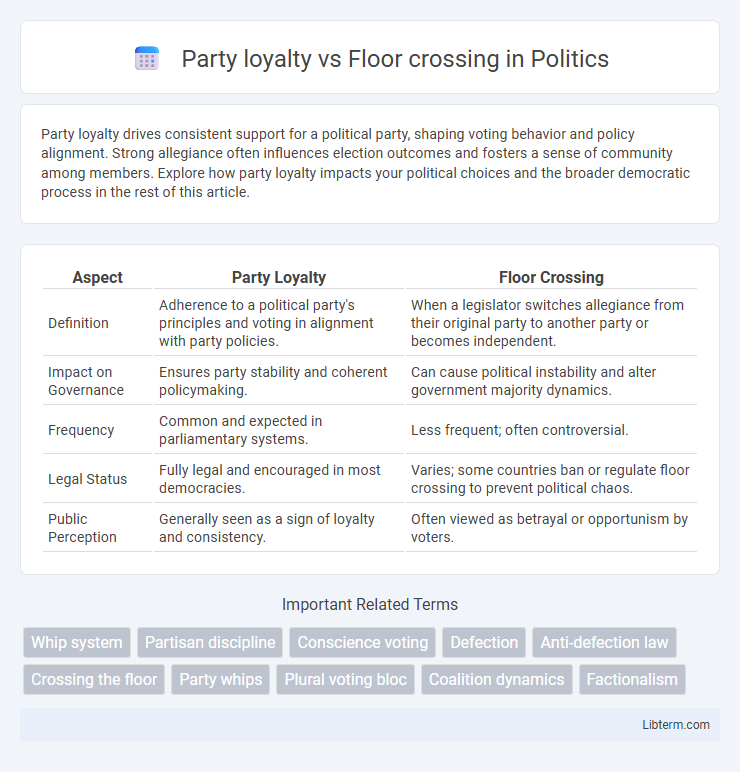Party loyalty drives consistent support for a political party, shaping voting behavior and policy alignment. Strong allegiance often influences election outcomes and fosters a sense of community among members. Explore how party loyalty impacts your political choices and the broader democratic process in the rest of this article.
Table of Comparison
| Aspect | Party Loyalty | Floor Crossing |
|---|---|---|
| Definition | Adherence to a political party's principles and voting in alignment with party policies. | When a legislator switches allegiance from their original party to another party or becomes independent. |
| Impact on Governance | Ensures party stability and coherent policymaking. | Can cause political instability and alter government majority dynamics. |
| Frequency | Common and expected in parliamentary systems. | Less frequent; often controversial. |
| Legal Status | Fully legal and encouraged in most democracies. | Varies; some countries ban or regulate floor crossing to prevent political chaos. |
| Public Perception | Generally seen as a sign of loyalty and consistency. | Often viewed as betrayal or opportunism by voters. |
Understanding Party Loyalty: Foundations and Importance
Party loyalty is rooted in shared values, ideology, and commitment to a political party's platform, ensuring unity and coherence in policy-making. It strengthens collective identity among members, fosters trust among voters, and stabilizes governance by preventing fragmentation. Understanding party loyalty is vital for recognizing its role in maintaining political order and enhancing effective representation.
The Concept of Floor Crossing Explained
Floor crossing refers to the practice where elected representatives switch allegiance from the political party under which they were elected to another party, often without triggering a by-election. This concept challenges party loyalty by allowing lawmakers to realign their political affiliation based on shifting ideologies or strategic advantages. Floor crossing can influence legislative dynamics, impacting government stability and policy decisions by altering party composition within a legislative body.
Historical Context: Party Loyalty vs Floor Crossing
Party loyalty in parliamentary systems has historically ensured stable governance by maintaining cohesive voting blocs aligned with party policies. Floor crossing, emerging as a practice primarily in the 20th century, challenged this stability by allowing legislators to switch parties mid-term, often reflecting shifts in political ideology or tactical maneuvering. Key historical examples include the frequent party realignments in post-colonial African democracies and the evolving party dynamics in Canadian provincial legislatures, where floor crossing has sparked debates on democratic representation and voter trust.
Motivations Behind Floor Crossing
Floor crossing often stems from personal political ambitions, ideological shifts, or dissatisfaction with party leadership, driving legislators to change allegiance. Strategic considerations such as increased influence, access to resources, or aligning with a ruling coalition motivate politicians to realign themselves. These actions reflect complex calculations about career advancement, policy impact, and constituency interests beyond mere party loyalty.
Impact on Political Stability
Party loyalty strengthens political stability by ensuring consistent policy implementation and maintaining voter trust through predictable governance patterns. Floor crossing, where elected representatives switch parties, often disrupts legislative majorities and can trigger government collapses or frequent elections, undermining political stability. The balance between these dynamics significantly affects the durability of political institutions and public confidence in the democratic process.
Ethical Considerations in Floor Crossing
Floor crossing raises significant ethical concerns by challenging the democratic mandate voters grant to elected representatives under a specific party platform. It can undermine political accountability and distort the representational legitimacy, as elected officials shift allegiances without direct voter consent. This practice often sparks debates on the moral responsibility of politicians to honor party loyalty versus personal conviction.
Case Studies: Notable Floor Crossing Incidents
Notable floor crossing incidents, such as the 2007 South African parliamentary shift where several members defected from the African National Congress to smaller parties, highlight the tension between party loyalty and individual political ambition. In the UK, the 2019 Brexit Party surge saw multiple MPs cross the floor, challenging traditional party alignments and impacting parliamentary dynamics significantly. These case studies emphasize the impact of floor crossing on party cohesion and legislative stability in democratic systems.
Voters’ Perspectives: Trust and Accountability
Voters often equate party loyalty with consistency and predictability, fostering trust in elected representatives who uphold their original mandates. Floor crossing can erode accountability, as constituents may feel betrayed when politicians switch allegiances, undermining the democratic principle of representation. The tension between party loyalty and floor crossing significantly impacts voter confidence and perceptions of political integrity.
Legal Frameworks Governing Floor Crossing
Legal frameworks governing floor crossing vary significantly across jurisdictions, often designed to balance party loyalty with individual legislative freedom. Some countries implement strict anti-defection laws to maintain party discipline, preventing elected officials from changing parties without forfeiting their seats. In contrast, other legal systems permit floor crossing under regulated conditions to promote political realignment and representative autonomy.
Balancing Party Interests and Individual Conscience
Balancing party loyalty and floor crossing involves managing the tension between collective party discipline and individual legislators' conscience, ensuring political stability while respecting democratic representation. Strict adherence to party loyalty preserves cohesive policy agendas, whereas allowing floor crossing accommodates personal convictions and responsiveness to constituents. Effective frameworks often include anti-defection laws and ethical guidelines to harmonize party interests with legislators' freedom of expression.
Party loyalty Infographic

 libterm.com
libterm.com